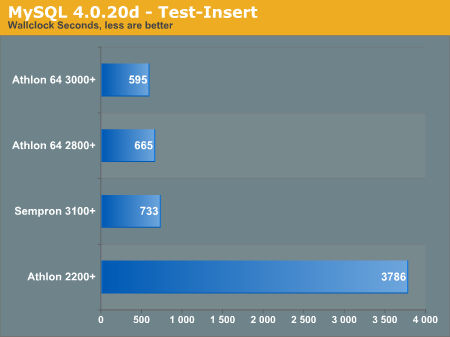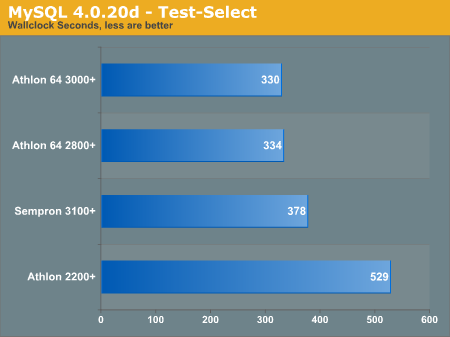Linux and L2 Cache; Sempron vs. Athlon
by Kristopher Kubicki on August 18, 2004 2:29 AM EST- Posted in
- Linux
We ran MySQLd 4.0.20d from 32-bit binaries precompiled by the SuSE team. The two benchmarks below are sql-bench's test-select and test-insert.


It is very likely there are a few different factors at work here that put the Socket 754 marks better than the lowly 1.8GHz Socket 462 Athlon 2200+. For starters, we have no doubt the on-CPU memory controller for the Socket 754 family plays a critical role in hastening selects and inserts. Our whole database is stored in memory, so the largest issue becomes IO from the CPU to the RAM. The nForce3 northbridge is also far superior to the nForce2 used on the Athlon 2200+ platform, which also accounts for some IO gains.










59 Comments
View All Comments
dougSF30 - Friday, August 20, 2004 - link
Kris,It doesn't matter if Intel is formally using GHz any longer or not. (And GHZ is still featured prominently in nearly every Intel part or system offered for sale today, but that is really beside the point.)
The simplest way to put it is, whether or not any of us LIKES it, Sempron PR is not designed to be equivalent to A64 PR.
Thus it is misleading to imply that there may be something wrong with the Sempron 3100+ PR rating based on relative performance with any A64 parts.
Sure, I'd like it if AMD copied Intel model numbers for all their parts, but there may be a legal reason they are hesistant to do so.
Anyway, just a small nitpick in an otherwise excellent review.
Doug
KristopherKubicki - Thursday, August 19, 2004 - link
Hi Doug,Since i noticed you copied your email along in the comments, ill copy your response back into the comments too:
Hi Doug,
I would agree with your logic except the fact that Celerons no longer go by any sort of similar rating system. If you look back to May before the Sempron line was announced, AMD was beginning to rollout a Product Code numbering scheme.
http://www.anandtech.com/cpuchipsets/showdoc.aspx?...
Then suddenly, this was scrapped from the roadmaps and AMD went back to the PR rating system, *after* the induction of the Celeron D line. You and I know the Sempron 3100+ competes against a Celeron D ~340 but that is definitely obscured by the PR rating.
Your claim is that since Intel uses a higher GHz rating for its older Celeron CPUs, AMD should be allowed to do the same for its budget Semprons. I don't think its acceptable for AMD nor Intel to use a PR or GHz rating system to sell their processors if they don't adhere by the same rating standards from processor to processor!
Let's face it, AMD already does it with the 3400+ and the 3500+; dual channel or not they perform within 1% of each other! Do dual channel Athlons get a different rating system than single channel? In the same argument do we claim half cache processors get a different rating system than full cache ones?
Kristopher Kubicki
Senior Editor, AnandTech.com
email: kristopher@anandtech.com
dougSF30 - Thursday, August 19, 2004 - link
Kris,AMD has made it very clear that the Sempron PR rating system is NOT equivalent to the A64 PR rating system.
So you can't conclude that you cannot "vouch" for the Sempron rating of 3100+, compared to the A64 3000+ or 2800+, as those figures are NOT MEANT to be compared.
Sempron PR is designed to rate against Celeron clockspeed, whatever AMD says officially about a "different suite" of benchmarks for legal reasons.
And A64 PR is designed to rate against the full P4.
So, given that Celeron performance is much less than P4 performance at the same clockspeed, another way to say this is:
For a given level of performance, Celeron clock is much higher than P4 clock.
Thus is follows automatically that Sempron PR is higher than A64 PR for a given level of performance.
It's not "moot" because Intel is also labeling Celeron parts with Model numbers... the point is still valid: Sempon PR is a completely different rating system than A64 PR.
The only way AMD could have been less confusing would have been to copy the Intel Celeron model numbers, with the Sempron "330" "340", etc., but there may be reasons (legal?) they cannot do that.
Pretty simple, no?
Doug
KristopherKubicki - Thursday, August 19, 2004 - link
Matt did you see this as well:http://www.anandtech.com/linux/showdoc.aspx?i=2163...
Youre getting higher numbers than i got with my Xeon 3.6GHz chip.
Kristopher
Matthew Daws - Thursday, August 19, 2004 - link
Some further comments about TSCP: I found an old article over at Ace's which used it. The numbers don't seem comparable, but the article does say that the P4 does very, very well. Still not sure why I am getting different numbers to you. Have you run the windows benchmark which can be downloaded: that should give an indication of the numbers you might expect on linux...--Matt
PrinceGaz - Thursday, August 19, 2004 - link
Interesting results but it would probably have been more relevant to the majority if it was the standard Windows benchmarks as everything was 32-bit.When I saw "L2 cache: Sempron vs Athlon" and "three 1.8GHz offerings from AMD", I really expected to see the Sempr0n 3100+ (256K), and Athlon 64 2800+ (512K) that you used, tested along with a Athlon 64 3200+ (1MB) set to a 9x multiplier. Then we'd see all three cache sizes on otherwise identical chips in 32-bit mode to truly show what effect L2 cache size has. Throwing in an Athlon XP instead as a third AMD 1.8GHz chip was rather meaningless as there are far too many other differences.
The results do reflect what we've seen in the past that the 512K -> 256K L2 cache halving doesn't have a significant impact on performance in most apps, certainly not the crippling effect it has on the P4 architecture. Of course with the exclusive 128K L1 cache we're really only looking at a 40% (640K -> 384K) cache reduction.
I've got to disagree with your conclusion I'm afraid. Given what is a very small price difference between the Sempr0n 3100+ and A64 2800+, spending the $20 extra for the A64 2800+ is a no brainer when you consider total system cost. Throw in just a S754 mobo and the performance difference alone already makes the A64 2800+ a viable option. People buying S754 systems aren't seriously looking to upgrade in the future (else they'd go S939). And being stuck with a Sempr0n 3100+ means you miss out on all the benefits of 64-bit in a year or two.
Matthew Daws - Thursday, August 19, 2004 - link
Kris: Hmm, well, using -O3 -march=pentium4, under Windows, I get with my Celeron 2GHz:GCC 3.3.3 -- 272K
GCC 3.4.1 -- 280K
GCC 3.3.3 (-02 -march=pentium4) -- 273K
GCC 3.3.3 (-O3 only) -- 262K
Just with pure clock-speed scaling, I'd expect 20% increase with a 2.4C, so 300K or so...
You shouldn't see any difference with linux: indeed, only a linux box I have access to, with GCC 3.2.2 (I *think* it's a P4 2.8GHz, but I'm not 100% sure: I'm doing a remote-login right now, so cannot check!) I get 365K with (-O3 -march=pentium4). This seems to be pretty linear clock scaling, which we might expect if the memory usage is low...
An Athlon *should* excel at this sort of test, at least given other benchmarks.
Just to check: I am using the source-code from Tom Kerrigan, at http://home.comcast.net/~tckerrigan/tscp181.zip
--Matt
KristopherKubicki - Thursday, August 19, 2004 - link
Hi Matt: Just -O2/3 -march=athlonI emailed a few people about your results. I have a 2.4C here that only does 250K with GCC 3.3.3
Kristopher
Matthew Daws - Thursday, August 19, 2004 - link
Kris: I don't have an AthlonXP, so I cannot comment. I was using GCC 3.4.1 (MinGW version for Windows) which might explain the difference. Still, I would expect any of the processors in this test to completely thrash my Celeron...What flags were you using with the AthlonXP? I'm pretty sure it's not an SSE(2) issue...
--Matt
KristopherKubicki - Thursday, August 19, 2004 - link
Matthew Daws: I was getting wild results with my TSCP on the athlon xp, which is why i didnt include it. I assumed there was some optimization somewhere that shouldnt have been.which GCC version are you using? on the a64 platforms ive seen as much as 30% increases using GCC 3.4.1 over 3.3.3.
Kristopher